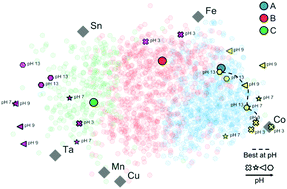Functional mapping reveals mechanistic clusters for OER catalysis across (Cu–Mn–Ta–Co–Sn–Fe)Ox composition and pH space†
Abstract
Identification of stable electrocatalysts for the oxygen evolution reaction (OER) remains a primary challenge in materials for energy. pH-Dependent activity is known for very few catalysts, prompting our exploration of a broad range of catalysts using high throughput experiments and data science. This approach enables the largest screening of OER activity and operational stability to date, as illustrated through investigation of the (Cu–Mn–Ta–Co–Sn–Fe)Ox composition space as 15 unique quaternary composition spaces. In total 2121 compositions are tested between pH 3 and 13, creating an extensive dataset whose interpretation requires development and application of data science to provide insights that are both beyond the standard composition–activity relationships and beyond human interpretation due to the dimensionality of the dataset. Three distinct classes of OER catalysts are identified with respect to pH-dependent activity and stability. The large-scale screening reveals a new class of Co-rich OER catalysts that can be compositionally tailored to a specified pH and perform on par with state-of-the-art acid OER catalysts.

- This article is part of the themed collection: International Year of the Periodic Table : Single Atoms as Active Catalysts


 Please wait while we load your content...
Please wait while we load your content...